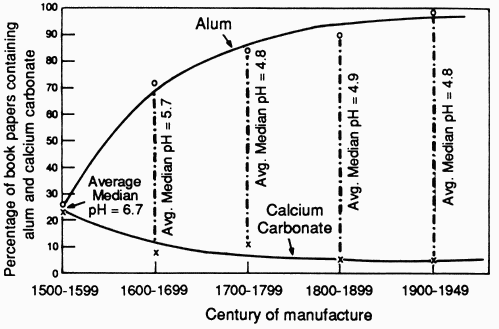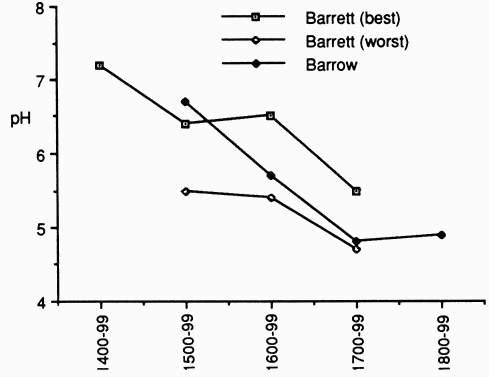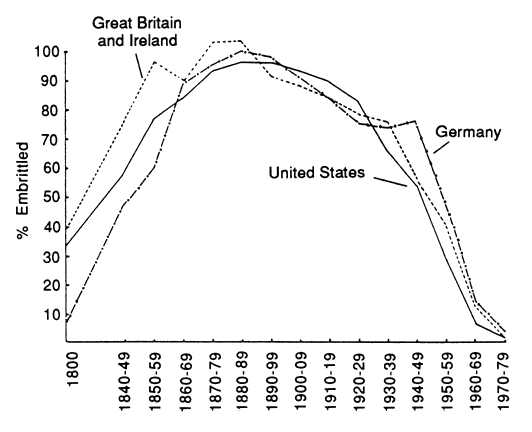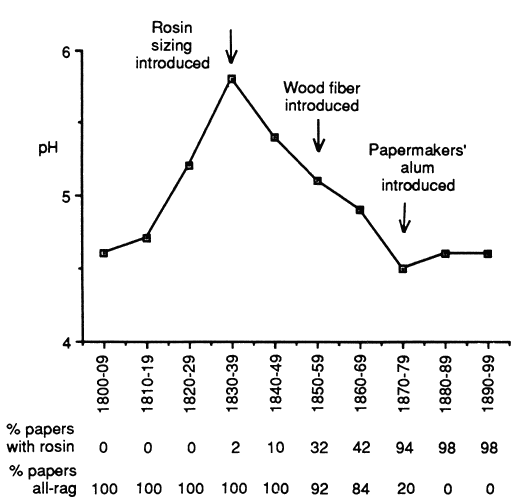

This is a revised version of the original paper entitled "Librarians and Archivists View Neutral/Alkaline Paper," which was presented at the 1990 TAPPI Neutral/Alkaline Papermaking Short Course, October 16-18, Orlando, Florida. Copyright TAPPI 1990.
I was introduced to the problem of brittle books in the 1960s when, as an ex-librarian, I opened my own hand bookbinding shop. Customers would bring in the fragile remains of their favorite old books and beg me to make them usable again. One of our institutional customers was a law library that regularly gave us hundreds of brittle old law books in powdery leat-her bindings, which we would transform into brittle old law books with acid-free end sheets and cloth bindings. We could fix the bindings, but there wasn't much we could do about the paper. We learned how to resew even the most brittle paper, but we knew that the paper could easily crack off along the sewn fold when the book was used and fall out.
After a few years I realized that rebinding didn't address the real problem, which was brittle paper, and I began to look for more satisfactory answers. I read everything I could find about paper permanence and deterioration. I became part of a nationwide inner circle of acid-free paper aficionados made up of bookbinders, printers, librarians, genealogists, and a few artists, archivists, and authors. What we had in common was mainly the long and sometimes fruitless search for "acid-free" papers, but we also enjoyed comparing notes on pH spot tests and swapping names of mills that made acid-free papers. Those days of scarcity are gone now, in this country at any rate, but the bond between aficionados remains.
Librarians, speaking for themselves and the others involved in keeping books and records, have always been strong and effective advocates of paper permanence. After all, they are known to be the dedicated custodians of 500-year-old and 1000-year-old books, and they have a lot of credibility on the topic of longevity, even if they are not able to discuss the chemistry of paper deterioration. They have been expressing their concern about the condition of book paper for a century or more, as can be seen in the pages of the 1964 IPC bibliography on permanence (Bibliographic Series No. 213).
Although preservation librarians are typically not technically minded, they do try to learn the concepts necessary to be effective advocates of paper permanence. Words like pH, calcium carbonate, groundwood, accelerated aging, fold endurance, and so on, are part of their vocabulary. Some of them use the phloroglucinol test to keep their board suppliers honest, and many know how to tell if a publisher is selling them books on acidic paper because they will test the books with chlorophenol red. They have learned from books, newsletters, preservation courses, chemists in the major cultural institutions, and each other about how to select papers and boards for perma-nence.
Now that alkaline paper is finally on the market in abundance, preservation librarians and archivists are lobbying for state laws requiring its use for government publications. Most of the state laws passed so far, however, are not likely to be very effective because they are so vaguely worded. A federal law, PL 101-423, passed in October 1990, makes it a "policy" to use alkaline paper in government offices and publications, and to use permanent paper for documents of enduring value. The law has no teeth in it, but it is well to remember that both this law and the vague state laws offer a foundation to build upon. They are the result of a grass-roots movement which is likely to gather strength as it goes along. Even the ANSI/NISO standard might never have been written without this grass-roots support.
Advocates of paper permanence have different concerns depending on their goals and activities. Many of them have to rely on the library community to do something about the situation because librarians can speak about the condition of paper with authority and can (sometimes) get the attention of the public and decision-makers. The stamp collectors focus on finding permanent albums and hinges for their collections, and sometimes worry about the paper the stamps themselves are made of; lawyers care mostly about legal papers and publications. Some artists deliberately choose short-lived materials like newsprint, sticky tape and felt-tip pens, while others prefer to use lasting materials. Serious collectors of comic books and photographs are generally careful to use archival envelopes and other enclosures, but do not concern themselves much about offset paper.
Best-selling authors do care about offset paper because the immortality of their words depends on the paper their books are printed on. They have been able to influence publishers, with some help from the New York Public Library. Genealogists, who typically run off their family histories on photocopy machines, often insist on "acid-free" copy paper because they have seen old family records disintegrate when they are handled, and they do not want the same thing to happen to their own family history. They have doubtless exerted some market pressure through copy centers around the country.
Many lawmakers, on the other hand, only want to use permanent paper for publications "of enduring value," and in fact Congress has instructed the Government Printing Office to identify the types of publications (legal documents, maps, catalogs, etc.) most likely to have enduring value so that the right paper can be used for them.
This policy is a step forward, but it is so timid that I can't see how it would work. Who can expect government offices to keep two kinds of every paper that is likely to be used for important documents--stationery, photocopy paper, cutsize and roll offset, and so on--and then to remember to use the right kind every time? Even if they could afford to keep two inventories of each kind of papers and use them consistently, I do not think anyone could predict what will be important to researchers, citizens and statesmen 30 years from now, let alone 300 years from now.
The use of permanent paper for nearly everything is possible now with over 200 brands of permanent paper available on the market. Although some kinds of paper are not manufactured yet to meet permanence specs, the choice is wide and likely to become wider. I advocate the use of permanent paper for everything, wherever price permits. My own scratch pads and letterhead envelopes are alkaline, and both of Abbey Publication's newsletters are printed on permanent paper. This is a bit extreme, I realize. Sometimes I will look for an alkaline paper of a certain sort, like 3" x 5" index cards, to see if it can be found anywhere, and I will look till I find it, even if it takes years. In the case of the index cards, yes, it did take years, and I finally had to buy a minimum of 10,000 cards to get the handful I needed, but I did find out where to get them and can pass this information on to other zealots.
Beginning in 1957, the Council on Library Resources gave a series of grants to document restorer William J. Barrow to enable him to set up a chemistry laboratory, demonstrate the extent of the brittle book problem and look for practical solutions. (He had already invented lamination with cellulose acetate.) He found two solutions: deacidification and manufacture of modern permanent/durable paper from wood pulp. Aqueous deacidification has become an accepted procedure, and the specs that he used for manufacture of his first permanent/durable paper, "Permalife," served the library community well as an informal permanence standard and provided a basis for the 1984 edition of the ANSI standard. It was largely because of Barrow's workthat nearly everybody now looks for "acid-free paper", rather than rag paper, when they need paper that will last a long time.
Barrow has been criticized for not having a chemistry degree and not publishing in the professional literature, as well as for having a prickly personality, but he had an instinctive feeling for what was important, and he knew how to use existing knowledge (namely, paper permanence research performed at the National Bureau of Standards and elsewhere) to bring about needed changes. After he died in 1967, chemists in his lab worked for 10 years more, carrying on his work and publication program. Results were published in about 10 little booklets, seven of which were in the series "Permanence/Durability of the Book." Those booklets, now hard to find, have strongly influenced public and professional opinion.
The Barrow Lab chose to get most of its test data from old book papers, rather than from test sheets, because the books had been naturally aged and the dates of manufacture of the paper could be closely estimated from the date of publication. The lab's studies show that alkaline paper was indeed made 500 years ago.1

Fig. 1. Alum and calcium carbonate in book papers (1507-1949), with
pH. (From Ref. 1 , Fig. 1)

Fig. 2. Fold endurance of book paper (1507-1949). From Ref. 1 Fig. 2).
The lab plotted the historical use of alum and calcium carbonate as well as pH (Fig. 1) and fold endurance (Fig. 2). Modern test methods and equipment, including accelerated aging, were used in these studies, and the tests were performed by staff chemists.
The lab's findings on the pH of early papers were confirmed by Timothy Barrett's 1989 study of papers from the 15th to 19th century.2 Data from the 1974 Barrow Lab study and Barrett's study are combined in Figure 3, which shows that from 1400 to 1700 most book papers were made between pH 5.5 and 7.0 or above. (Since the pH of paper declines with age, especially in cities where the air is polluted, the pH at the time of manufacture must have been higher than that shown. It is hard to tell just how much higher it was to start with, however. The pH of sound, stable paper declines very slowly, while the pH of poor quality paper declines very rapidly in the absence of buffers like alum and calcium carbonate.)

Fig. 3. The pH ofbook papers, by century. Barrett's samples for the
best quality paper from 15th and 16th century books ar small (* for
each century), and his sample for the worst papers from the 16th
century is even smaller (4 papers), while Barrow's sample for the
16th century is 45 books. Data from Barret, p.39 and Barrow, Ref. 1, p. 43).

Fig. 4. Percentage of books surveyed that were brittle (Paper broke
after two or four folds), by date and countries. (Fig. 5 from the
Yale survey, Ref. 5. Reproduced with the
permission of the American Library Association. Copyright ALA
1985>
 Fig. 5. The pH of 19th century bookpapers, by decade (cold extraction,
uninked section), From Ref. 5, Table 3).
Fig. 5. The pH of 19th century bookpapers, by decade (cold extraction,
uninked section), From Ref. 5, Table 3).
Figures 3 and 5 show that the pH of the average book paper was almost as low by 1800 as it was ever going to get, even before the introduction of alum-rosin sizing. This may have been due to the over-use of chlorine bleach, introduced in papermaking in 1792 and condemned by John Murray in the 1820s.3 Average pH peaked in the 1830s and fell to a second low in the 1870s. The cause of the first low-pH episode around 1800 is not clear; neither is it clear why so many books made in the early 1800s have survived in good condition. Only about half of the books from the earliest 1800s are now brittle. This is shown in Figure 4, which presents data from a 1985 sample survey of Yale University books.4 Perhaps low pH was the only significant problem these papers had, and the use of high-quality fiber (cotton) minimized its effect. The gelatine surface sizing in use at the time must have helped too. There is some evidence that gelatine sizing protects cellulose against acidity, even though it is on the acid side itself.
Most books that are now brittle were printed between the Civil War and the first World War. The curves in Figure 4 show that books from all three countries become more brittle as you move forward in time from 1800 to 1880. Going forward from about 1900, books are less and less brittle on the average, but this is mostly because they have not yet lost their strength. A hundred years from now, we can expect nearly all books published between the Civil War and 1980 to be brittle.
A mild form of alum (potassium aluminum sulfate or potash alum) was used from 1650 onward, even before the introduction of rosin size, to regulate the viscosity and sizing efficiency of the gelatin size and keep it from putrefying in the tub. This milder form of alum was also used with rosin sizing in the United States, until it was replaced by the more concentrated aluminum sulfate, "papermakers' alum," after 1876. The reason this change was not reflected in a lower pH after 1876 is that alum has a buffering effect between pH 4.5 and 5.5 or so.
In another study, Barrow analyzed 500 books from the 1800s, 50 from each decade, for seven variables related to permanence and durability. A comparison of Figures 5 and 6 shows how first pH and then strength declined after the 1830s, despite the fact that almost all papers were still made of cotton until the 1870s. Figure 6 shows that fold endurance declined further and sooner than tear resistance.5
For many years, the decline in paper quality during the 19th century was blamed on the use of wood fiber, and it still is in some circles, but we cannot accept that explanation for two reasons: first, the decline was well underway before the use of wood became general (Fig. 2); and second, paper of great chemical stability and permanence is made every day of purified wood pulp. Barrow has been credited for shifting the blame for brittle paper from environmental conditions and use of wood fiber to the use of alum/rosin sizing.6
Nevertheless, Barrow's own data, published as graphs for the first time in Figures 5-7, make clear how inadequate these single-factor explanations are. They show that certain papers can survive even with a low pH, but acidity and groundwood together make embrittlement inevitable.
There are other factors in permanence, of course, including those identified through experimental work as well as through historical studies like Barrow's. When all factors are brought together, they present a picture of technological change too rapid and complex for the consequences to be observed, much less controlled, with the analytical methods then available. Verner Clapp's article is a very readable narrative of the historical changes that set the stage for the impermanent paper of 1870 onward and of how Barrow documented it through analysis of old books.

Fig. 6. Strength of 500 nineteenth century book papers, by decade.
(From Ref. 5, Table 3).

Fig. 7. Book papers containing groundwood, 1830-1949. Books
tested/decade: 1830-1899, 50; 1900-1949, 100. (From Ref. 1, p. 41).
By focusing on books that are brittle now, in 1994, I have perhaps under-reported the problem, which is bound to grow with time. We know that all books will eventually become brittle or fragile though some of them may take a thousand years or more to lose all their strength. Even books that are deacidified and given the best of care, and those originally printed on the finest rag paper, will eventually become brittle or tender. What is unusual about the brittle books of today is that they come from the same period of production and have reached a terminal state so quickly, while many of them are still in active use.
In the last 15 years, dozens of libraries have surveyed their book collections to see what condition they are in and what treatment they need. Older libraries without air conditioning, especially those in major cities where air pollution is heavy, have the largest proportion of brittle books. New York Public Library is badly affected with 50% of its collection brittle. Air-conditioned libraries, as well as those in nonindustrial towns or with newer collections, may have embrittlement rates of only 10%.
Opinion is divided on what to do about these brittle books, estimated to number over 76 million and growing in number yearly. Congress is funding the microfilming of three million of them in a 20-year program. This is a feasible solution, but it is not a cure-all. The master films may deteriorate and become useless if not stored under the right conditions (and recent surveys have shown that some are not); microfilm is not popular with readers; certain kinds of research are impossible with microfilm (e.g., comparing texts); it costs $100 to film a book; and it may be difficult in practice to find a copy of a microfilm that is supposedly available for purchase or loan.
The selection of books to microfilm has become an issue since many books are filmed only because they belong to an important collection, or for some other reason, regardless of whether they are brittle and regardless of whether anyone has used them in the last 100 years. Brittle books are in no danger as long as nobody uses them; they don't fall apart on the shelf. Since funds are limited, why not concentrate on the small fraction of the total collection that is used? There is a growing consensus that books should be chosen for copying or treatment on the basis of three factors: use, value and condition.
Others are placing their hopes in paper strengthening techniques. The two major methods (parylene and graft copolymerization of ethyl acrylate, methyl methacrylate and hexane 1.6 diol-diacrylate by gamma radiation) work in the gaseous phase. Parylene is now on the market but is so expensive that it is only used for the most valuable books. The other method is being developed for the British Library and is now in the pilot phase.
Encapsulation in Mylar was developed at the Library of Congress almost 20 years ago for brittle posters and other documents and has even been used for the pages of books, though it is very time-consuming and requires special skills to bind the encapsulations back into book form. Recently it has been learned, however, that encapsulating a sheet of acidic paper will greatly shorten its life, unless the paper is deacidified first either by hand using an aqueous solution or by some mass process. This makes encapsulation a less attractive option because deacidification is risky and expensive for non-conservators to do, and time-consuming for conservators.
Mass deacidification, to prevent brittleness from developing, will probably not see wide use in the next few years.
Reprinting of brittle books on demand through digital scanning promises to be popular and feasible, but it will still mean delay and expense for some readers.
All things considered, the best solution is to use permanent paper, or at least alkaline paper, for everything, as soon as possible. Future generations of librarians and archivists will be obliged to care not only for the crumbling books and records produced between the Civil War and the First World War, but for those produced between 1945 and 1980, most of which will soon go brittle. The least we can do is to keep their burden from getting any heavier. This point of view is expressed in a document sent to Congress in December, excerpted below.
[PL 101-423, the 1990 law that establishes a national policy on permanent papers, requires a report every two years from the three "lead agencies" (LC, GPO and NARA) on implementation of that policy. The most recent report was sent to Congress in December 1993. The executive summary reads, in part, as follows.]
"...All three lead agencies are in agreement that market trends are not the only answer to ensure a fulfillment of the goals of PL 101-423. A cooperative effort of the agencies along with the General Services Administration will be required to see that the proper standards, specifications, procedures, and supplies are in place to serve the needs of the Federal government.
"Further, all agencies agreed that a proper implementation of the law required that two other challenging issues be resolved. First of all, if all records of enduring value cannot be identified at the point of their creation, how can we implement a policy that requires only records of enduring quality be created on permanent papers? The agencies have agreed that a policy that requires all records to be created on a more long-lasting paper is the solution. However, this brings us to the second major issue. If the implementation places any additional cost burden on Federal agencies, it will not be feasible. In 1991, paper that meets both the requirements of chemical stability and durability (truly permanent paper) is significantly more costly than non-permanent papers. Alkaline paper, due to its chemical stability, is more long-lasting than acidic papers and is competitively priced.
"The lead agencies are therefore recommending the advancement of an alkaline paper standard for the Federal government as an economical interim step toward our ultimate goal of permanent papers. Records and publications that are clearly permanent at the time of creation should be recorded on permanent paper. All others should be recorded on alkaline papers...."
1. Physical and Chemical Properties of Book Papers, 1507-1949. (Permanence/Durability of the Book, VII). W.J. Barrow Research Laboratory, Richmond, 1974, p. 41, 43-45. Figure 1 and Table 2.
2. Timothy D. Barrett, Early European Papers/Contemporary Conservation Papers: A Report on Research Undertaken from Fall 1984 through Fall 1987, Institute of Paper Conservation, Leigh (Worcester, England), 1989. Issued as v. 13 (1989) of The Paper Conservator, p. 39. App. 4.5.
3. Thomas Collings and Derek Milner, "A New Chronology of Papermaking Technology," The Paper Conservator, v. 14, 1990, p. 59.
4. Gay Walker, Jane Greenfield, John Fox and Jeffrey S. Simonoff, "The Yale Survey: A Large-Scale Study of Book Deterioration in the Yale University Library," College & Research Libraries 46: 111-132, March 1985. [Figure 5 is reproduced here, with permission of the American Library Association, as Figure 4.]
5. Strength and Other Characteristics of Book Papers 1800-1899. (Permanence/Durability of the Book, V), W.J. Barrow Research Laboratory, Richmond, 1967, Table 3.
6. Verner Clapp, "The Story of Permanent/Durable Book-Paper, 1115-1970," Restaurator, Suppl. #3, 1972. 51 pp. Reprinted from Scholarly Publishing, 2 (1971): 107-24, 229-45, 353-67.